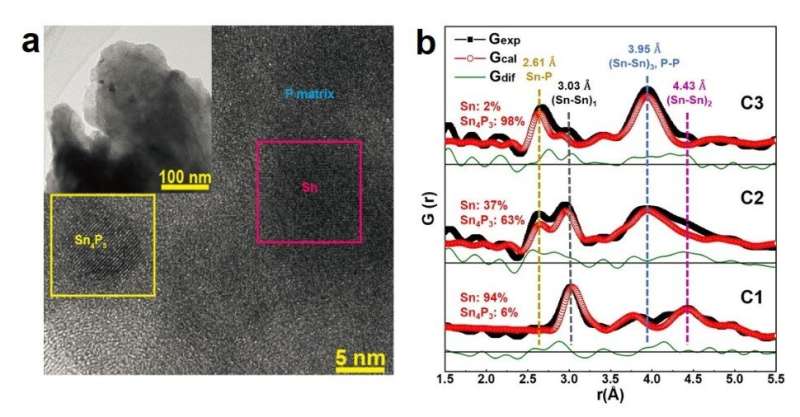Newly developed composite may enable high effective energy storage

Sodium-ion batteries are an exciting alternative for post-lithium energy storage, while their anode materials of high performance are still limited. Phosphorus-based materials enable high-capacity anodes for sodium-ion batteries, but often face poor performance retentions owing to low conductivity and large volume expansion. To produce a cost-effective sodium-ion battery, researchers based at the Beijing University of Technology, have synthesized a series of P-/Sn-based composites that serves as high-capacity and high-stability anode materials, enabling a full battery that retains a capacity retention of 97.7% after 50 cycles.
The researchers, led by Haijun Yu, professor in the Institute of Advanced Battery Materials and Devices, Faculty of Materials and Manufacturing at Beijing University of Technology, effectively tailor the architectures of components in the P-/Sn-based composites for high stability by the facile and low-cost one-step ball milling. They published their approach on 1 October in Energy Material Advances.
"Considering the high abundance and low cost of sodium resources, sodium-ion batteries are expected to be a vital alternative to the extensively used lithium-ion batteries", according to the leading corresponding author Haijun Yu, professor at the Beijing University of Technology. High-capacity anode materials, e.g., phosphorus, have gained wide attentions as for their high theoretical capacities, low discharge voltages, and low costs, Yu said. "However, phosphorus often suffers from large volume expansions, leading to many problems, such as structural collapse, particle pulverization, and thus rapid performance decay. It is thus essential to buffer these problems by appropriately alloying with other elements such as tin and constructing well-designed microstructures."
"The development of low volume expansion and long cycle stable phosphorus-based composite anode materials has become an urgent issue", Yu said, "it is of great significance to develop cost-effective and scalable approaches to elegantly adjust the microstructures of composites to eliminate their drawbacks." In their paper, a series of P-/Sn-based composites have been synthesized by the facile and low-cost one-step ball milling. An optimal structure comprising of crystalline nanodomains such as Sn4P3, and Sn embedded and separated in an amorphous phosphorus matrix is thus realized. This architecture hinders the aggregation of metallic Sn-based particles and improves the conductivity of amorphous phosphorus, thereby improving the efficiency of electrochemical reactions. Moreover, owing to the small size of crystalline domains and amorphous nature of phosphorus, the volume expansion induced particle collapse is suppressed, enabling the material with high stability.
Another challenge for such highly disordered composite anode materials is how to gain local structure information of diverse microstructures by average means, that is, probing macroscopic amounts of materials rather than testing a very limited region. Pair distribution function, PDF for short, is newly introduced here as a hardcore quantitative technique to elucidate their structures combined with other techniques, suggesting the formation and ratios of Sn4P3 and Sn crystalline domains embedded inside the amorphous matrix.
The PDF is a powerful characterization technique, which can not only provide local structure information for complicated systems but also quantify the components in ordered or even disordered materials. Li and Huang noted that the team also innovated new approaches, including using atom PDF for the first time to quantitatively analyze the structure and proportion of SnPx crystalline domains.
Sodium-ion batteries are expected to be a vital alternative to the extensively used lithium-ion batteries by considering the high abundance and low cost of sodium resources, according to the first author, Baixu Chen. On his survey of electrode materials for sodium-ion batteries, phosphorus and tin are chosen because of their high theoretical capacities, low discharge voltages, and low costs. "The study sheds light on the rational design and concrete identification of P-/Sn-based amorphous-dominant composite materials for sodium-ion batteries", Chen said.
The researchers noted that the study well adjusts and identifies the components and microstructures of P-/Sn-based anode materials, providing insights into the design of high-performance anode materials for sodium-ion batteries.
More information: Baixu Chen et al, Sodium-Ion Battery Anode Construction with SnPx Crystal Domain in Amorphous Phosphorus Matrix, Energy Material Advances (2021). DOI: 10.34133/2021/9795825
















